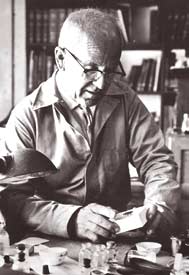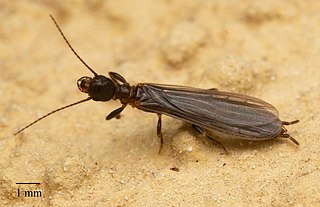Related Research Articles
Syndaesia mastix is a species of arachnids in the order Solifugae, and the only member of the genus Syndaesia. It lives in western Argentina, and is one of only two daesiids in South America, the other being Ammotrechelis goetschi from the Atacama Desert; all other South American solifugids are in the families Eremobatidae and Ammotrechidae.

The Hellstrom Chronicle is an American film released in 1971 which combines elements of documentary, horror and apocalyptic prophecy to present a gripping satirical depiction of the struggle for survival between humans and insects. It won both the 1972 Academy Award for Best Documentary Feature and BAFTA Award for Best Documentary. It was conceived and produced by David L. Wolper, directed by Walon Green and written by David Seltzer, who earned a Writers Guild of America Award nomination for his screenplay.

Zopherus chilensis, also commonly known as the ma'kech or jewelled bug, is a species of ironclad beetle in the family Zopheridae. Despite the name "chilensis", nearly all of the known specimens have been found from Mexico to Venezuela.

Maindroniidae is a very small family of silverfish, basal insects belonging to the order Zygentoma. It contains just a single genus, Maindronia, and a handful of species.
Roy R. Snelling was an internationally renowned American entomologist who studied Hymenoptera, mainly ants, wasps and bees. He was the emeritus collections manager at the Natural History Museum of Los Angeles County where he worked for over 30 years, joining the museum in 1963 and retiring in 1993. He dedicated his professional life to making insect biodiversity better known and appreciated.
Eutachyptera is a monotypic moth genus in the family Lasiocampidae. The genus was erected by William Barnes and James Halliday McDunnough in 1912. Its single species, Eutachyptera psidii, was first described by Sallé in 1857. It is found in Mexico.

Chiasognathus grantii is a species of stag beetle found in Argentina and Chile. It is known as Darwin's beetle, Grant's stag beetle, or the Chilean stag beetle.

Cycloneda sanguinea, also known as the spotless lady beetle, is a widespread species of ladybird beetle in the Americas.

Human interactions with insects include both a wide variety of uses, whether practical such as for food, textiles, and dyestuffs, or symbolic, as in art, music, and literature, and negative interactions including damage to crops and extensive efforts to control insect pests.

Synoeca is a genus of eusocial paper wasps found in the tropical forests of the Americas. Commonly known as warrior wasps or drumming wasps, they are known for their aggressive behavior, a threat display consisting of multiple insects guarding a nest beating their wings in a synchronized fashion, and an extremely painful sting. The sting is barbed and if used often kills the wasp, which may be the reason why such a striking defensive display is used. This display escalates from drumming inside the nest to hundreds of wasps moving on to the envelope of the nest and continuing to drum. If this does not deter the threat only then do the wasps begin to sting.

Armadillidae is a family of woodlice, comprising around 80 genera and 700 species. It is the largest family of Oniscidea, and one of the most species-rich families of the entire Isopoda. Armadillids generally have a strongly convex body shape, with some rather shallowly convex. Like members of the woodlice family Armadillidiidae, armadillids are capable of enrolling into a sphere (conglobation), and are commonly known as pill bugs. Armadillids differ from the Armadillidiidae in that the antennae are fully enclosed within the sphere.

The western corsair is a species of assassin bug and is one of the two species of "two spotted corsairs", the other being Rasahus biguttatus. The adults have an orange and black body and an orange spot on each wing. They feed primarily on other insects and after dark are attracted to bright lights. Unlike most of the other assassin bugs, the bite of the western corsair can be extremely painful.

Charles F. Harbison (1904–1989) was an American entomologist and the curator of entomology at the San Diego Natural History Museum from 1942 to 1969. An avid field naturalist and researcher, Harbison influenced a generation of San Diego-born scientists in many fields of natural history through the Junior Naturalist program at the museum.
The Lorquin Entomological Society is a century-old association of professional and amateur entomologists, biologists and naturalists that meet regularly to study and promote entomology and natural history, especially about wildlife in and near Southern California.

Oligotoma nigra, also known as the black webspinner, is a species of insect in the order Embiidina, also known as Embioptera.
Pterinoxylus spinulosus is a species of stick insect found in the Neotropics. It was first described by the Austrian entomologist Ludwig Redtenbacher in 1908, from an adult male and an immature female. It was not until 1957 that an adult female was described by J.A.G. Rehn.

Capnobotes fuliginosus is a species of katydid known as the sooty longwing. It is found in the western United States and Mexico. It is omnivorous and it is the prey of the wasp Palmodes praestans.
Apterobittacus is a genus of hangingflies in the family Bittacidae. There is one described species in Apterobittacus, A. apterus.

Azteca muelleri is a species of ant in the genus Azteca. Described by the Italian entomologist Carlo Emery in 1893, the species is native to Central and South America. It lives in colonies in the hollow trunk and branches of Cecropia trees. The specific name muelleri was given in honour of a German biologist Fritz Müller, who discovered that the small bodies at the petiole-bases of Cecropia are food bodies.

Neoponera villosa, known generally as hairy panther ant, is a species of ant in the family Formicidae. Other common names include the greater Texas bullet ant and giant hunting ant.
References
- ↑ Hogue, Charles Leonard (1993-01-01). Latin American Insects and Entomology. ISBN 9780520078499.
- ↑ Powell, Jerry A.; Hogue, Charles L. (September 1980). California Insects. ISBN 978-0520037823.
- ↑ Charles L. Hogue, Cultural Entomology. Annual Review of Entomology, 1987, Vol. 32: 181-199.
- ↑ The New York Times Movies - The Hellstrom Chronicle (1971) Production Credits
- ↑ The Hellstrom Chronicle at IMDb
- ↑
- Charles L. Hogue (1974). Insects of Los Angeles Basin. Natural History Museum of Los Angeles County. ISBN 978-0-938644-32-3.
- ↑
- Jerry A. Powell, Charles L. Hogue (1981). California Insects. University of California Press. ISBN 978-0-520-03782-3.
- ↑
- Charles L. Hogue (1993). Latin American Insects and Entomology. University of California Press. ISBN 978-0-520-07849-9.
- ↑ Charles L. Hogue (1972). The Armies of the Ant . World. pp. 234. ISBN 978-0529045508.